These devices will open the way to significant cost savings and new applications for high-power laser diode arrays.
Dr. B.L. Volodin, S.V. Dolgy, E. Downs, E.D. Melnik, J. Shaw,
Dr. V.S. Ban and E. McIntyre, PD-LD Inc.
High-power multimode laser diodes, emitting >1 W per diode, and laser diode arrays, emitting tens or even hundreds of watts, have many important applications, such as medicine, materials processing and pumping solid-state lasers. The market for them in areas other than telecommunications is strong and growing.
These devices typically emit approximately 1 W from a 100 × 1-μm area, although some can emit as much as 4 W from an aperture of this size. The spectral characteristics of their emission, however, typically are not very tightly controlled. The center wavelength is usually specified at ±3 nm, and the spectral width is about 3 nm full width half maximum.
The emission wavelength changes significantly with temperature; i.e., dλ/dT = 0.3 nm/°C. It also increases with aging of high-power devices (the so-called red shift), limiting the useful lifetime of laser diodes to about 10,000 hours of operation. Considering that the diodes may cost upward of $10 per watt of optical power — even when used in very large numbers, such as for Nd:YAG-pumping laser diode bars — and hundreds of dollars per watt in the case of single emitters, the short lifetime is definitely undesirable.
PD-LD Inc. of Pennington, N.J., recently demonstrated a technology for greatly improving the spectral characteristics of high-power laser diodes by using proprietary holographic volume Bragg gratings called LuxxMaster that lock and narrow the emission wavelength (see Table). A volume Bragg grating element can transform multimode high-power laser diodes or diode bars into extremely narrowband emitters with a precisely defined center wavelength and a very low sensitivity to temperature changes. This capability will most likely enable significant improvements in a variety of laser diode applications.
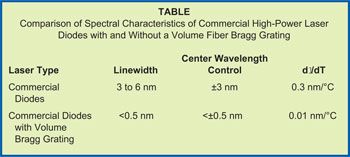
Volume Bragg gratings in glass
Most of the commercially significant technologies based on the volume phase holograms use the photosensitive dichromated gelatin as a recording medium, with some work also done on photorefractive polymers and electro-optic crystals. In contrast, this volume Bragg grating technology is based on a proprietary inorganic photorefractive glass that changes index of refraction in areas exposed to UV radiation.1,2,3 Because that glass is silica-based, the produced holographic filters are very stable both physically and chemically, in contrast to filters recorded in dichromated gelatin, photorefractive plastics or crystals, which often encounter problems with dimensional stability, permanence of recording or low optical damage threshold.
Volume Bragg grating filters have been tested to 200 °C and have shown no performance degradation. Their physical properties, such as chemical stability, hardness and optical damage threshold, are very similar to other common optical glasses, such as BK 7. Furthermore, their typical thickness ranges from approximately 0.5 to 10 mm — much thicker than, for example, dichromated gelatin films, which usually are <0.05 mm thick. The thickness of the Bragg grating d is responsible for its bandwidth Δλ:

where λ is the Bragg wavelength, n is the bulk refractive index, Λ is the period of the grating and N is the number of grating planes that fit in the thickness of the material. This accounts for the extremely narrow bandwidth of these filters (typically from 0.05 to 0.5 nm).
The ability to pull in the center wavelength of the laser to extreme levels of accuracy and to maintain it for the lifetime of the laser delivers tremendous cost-saving implications. Improved laser yields at the wafer level and the ability to produce lasers at precise wavelengths that were thought to be economically unattainable in volume can now be realized.
A volume Bragg grating can be used to control the emission spectrum of high-power laser diodes (Figure 1). A 0.1- to 0.5-nm-wide portion of the emitted laser light reflects into the laser diode, while other wavelengths pass through. The volume Bragg grating thus “self-seeds” the laser with narrowband light, and the laser diode is forced to lase at the injected wavelength determined by the grating element. The center wavelength of the grating can be controlled with much better accuracy than that of high-power laser diodes (<0.5 nm).
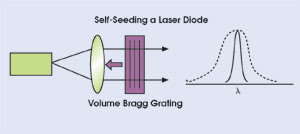
Figure 1. A volume Bragg grating filter, placed in front of a laser diode chip after the collimating lens, reflects a narrow portion of the emitted light back into the laser cavity, forcing it to lase at its own peak wavelength.
A popular similar approach is the deployment of fiber Bragg gratings for stabilizing the single-transverse-mode 980-nm lasers that are used to pump the erbium-doped fiber amplifiers. However, this requires the pump laser to be coupled into a single-mode optical fiber, which in practice means that only one single-mode laser per fiber Bragg grating can be locked. The advantage of the volume Bragg grating, on the other hand, is that the source doesn’t need to be coupled into fiber at all, making possible simultaneous stabilization of the entire multimode laser diode bar with a single volume Bragg grating element. Moreover, the grating elements can easily withstand the emitters’ high power.
As an illustration of the application of the volume Bragg grating technology to wavelength locking of high-power laser diodes, we used commercial laser diodes and bars emitting at 808 nm, the wavelength used for pumping Nd:YAG solid-state lasers (Figure 2). Commercial C-mount diodes packaged in TO cans and bars were tested.
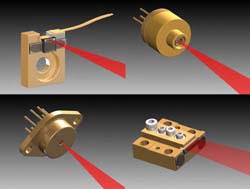
Figure 2. Wavelength-stabilized lasers in C-mount, 9-mm, TO-3 and diode bar package types have a cylindrical lens and LuxxMaster element in front of it.
In comparing the emission spectrum of a 40-W diode array with and without the wavelength-stabilizing volume Bragg grating element at different operating currents and heat sink temperatures, we found that these elements significantly narrow the emission spectra by a factor of 3 to 10 and peg the center wavelength to their reflectivity peak (Figure 3).
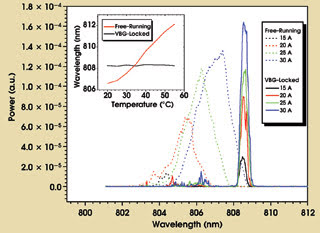
Figure 3. The output spectra of a free-running and LuxxMaster- locked 40-W laser diode bar are compared at different currents. The inset shows a comparison of the temperature-induced wavelength drift. Note that the volume Bragg grating (VBG) was not attached to the bar.
After comparing the power output of a locked laser diode bar with a free-running diode bar, we found that the wavelength stabilization and narrowing delivered by LuxxMaster do not greatly reduce the power (Figure 4). Most of the output power of the laser is concentrated within a 0.2-nm-wide peak.
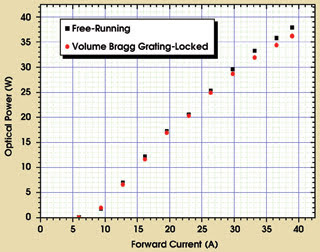
Figure 4. The total output power of a free-running laser diode bar and the off-the-shelf 40-W locked LuxxMaster laser diode bar are compared.
The pump laser diode’s narrow linewidth and the stability of the output wavelength are very important (Figure 5). In the example of the 808.7-nm line of the Nd:YAG, wavelength narrowing drastically increases the effective absorption coefficient of the pump light in the laser crystal, which at the same time necessitates higher accuracy and stability of the output wavelength. All three characteristics are achieved by use of the volume Bragg grating technology.
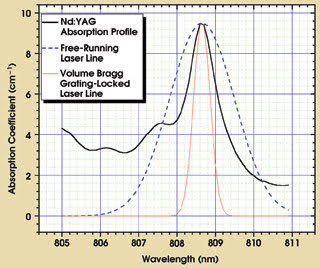
Figure 5. With the emission stabilized, the Nd:YAG pumping efficiency can be readily optimized. The pumping efficiency remains consistent over the wide range of temperatures and drive currents.
New applications
Although locking and narrowing the wavelength of high-power laser diodes and arrays have been demonstrated by other technologies, all of these approaches require a complex multicomponent optical system comprising gratings, lenses and mirrors placed in front of the laser diode to achieve the effects similar to those described above. In contrast, the volume Bragg grating approach simply requires a small flat piece of glass and a cylindrical microlens, which is often installed on laser diode bars for other purposes. Thus, the geometry and size of the high-power laser diode single emitters equipped with a volume Bragg grating do not change in any significant way. The simplicity of this method makes it attractive and commercially viable.
The improved emission characteristics of volume Bragg grating-locked diodes will lead to new uses for high-power lasers. These include diode-pumped solid-state lasers based on new host materials. Medical and sensing applications will emerge, such as spin-exchange optical pumping for hyperpolarizing the noble gases for use in lung magnetic resonance imaging diagnostics, as these need wavelength stability and/or high power in a narrow spectrum. This volume Bragg grating technology provides far-reaching benefits.
Acknowledgments
The authors thank professor Steve Forrest from Princeton University and his students S. Datta and C. Li for consultation, and C. Zaic of PD-LD for assistance in experiments and manuscript preparation.
References
1. J.E. Pierson and S.D. Stookey (November 1977). US Patent No. 4,057,408.
2. L.B. Glebov (1988). Glass Science and Technology, Vol. 71C, pp. 85-90.
3. O.M. Efimov et al (1999). APPLIED OPTICS, Vol. 38, No. 4, pp. 619-627.
Meet the authors
Boris L. Volodin is director of research and development at PD-LD Inc. in Pennington, N.J. Vladimir S. Ban is the CEO and president of the company; E. Downs and J. Shaw, technicians; E. McIntyre, director of marketing; and S.V. Dolgy and E.D. Melnik, engineers.
The Advantages of Using Volume Bragg Gratings
• Self-seeding dramatically improves the spectral characteristics of high-power laser diodes.
• A single volume Bragg grating element enables simultaneous locking of multiple multimode laser diodes in a bar or a stack.
• The technology is applicable at any wavelength or power level.
• Volume Bragg grating locking is cost-effective and simple to implement.
• Lifetimes of volume Bragg grating-locked laser diodes can be extended by virtually eliminating the red shift.
• Wavelength pulling by the volume Bragg grating can significantly increase manufacturing yields of high-power laser diodes.
• Cooling requirements are reduced.
• The grating improves the economics of diode-pumped solid-state lasers by increasing pumping efficiency, extending lifetime and relaxing cooling requirements.
• Improved emission characteristics of volume Bragg grating-locked diodes will lead to new applications of high-power lasers.
• Pumping efficiency remains consistent over a wide range of temperatures and drive currents.